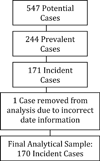Peanut allergy diagnoses among children residing in Olmsted County, Minnesota
- PMID: 22944484
- PMCID: PMC3553546
- DOI: 10.1016/j.jaci.2012.07.042
Peanut allergy diagnoses among children residing in Olmsted County, Minnesota
Abstract
Background: Peanut allergy is a major health concern, particularly in developed countries. Research indicates that as many as 2% of children are allergic to peanuts, which represents a 3-fold increase in diagnoses over the past 2 decades.
Objective: This population-based descriptive study used the Rochester Epidemiology Project to estimate the prevalence in 2007 and annual incidence rates of peanut allergy diagnoses from 1999 to 2007 among children residing in Olmsted County, Minnesota.
Methods: Residents of Olmsted County from January 1, 1999, through December 31, 2007, who received medical care at a Rochester Epidemiology Project facility and provided research authorization were eligible for the study. A medical chart review of 547 potential diagnoses resulted in 244 prevalent and 170 incident cases. Annual rates, crude and adjusted for age and sex, were standardized with the use of the indirect method to the Olmsted County population data in 1999. Incidence rate ratios were estimated with Poisson regression.
Results: The prevalence in 2007 was 0.65%. Female children were less likely to be diagnosed than male children (incidence rate ratio = 0.18; 95% CI, 0.07-0.48). Children aged birth to 2 years were significantly more likely to be diagnosed than older children aged 3-17 years (incidence rate ratio = 0.001; 95% CI, 0.0004-0.004). A significant 3-fold increasing trend was observed in diagnoses over time from 2.05 cases per 10,000 children in 1999 to 6.88 cases per 10,000 in 2007.
Conclusions: Peanut allergies are an increasing concern in Olmsted County, Minnesota, as indicated by a 3-fold increase in diagnoses from 2.05 per 10,000 children in 1999 to 6.88 per 10,000 children in 2007.
Copyright © 2012 American Academy of Allergy, Asthma & Immunology. Published by Mosby, Inc. All rights reserved.
Figures



References
-
- Gupta R, Springston E, Warrier M, et al. The Prevalence, Severity and Distribution of Childhood Food Allergy in the United States. Pediatrics. 2011;128(1):e9–e17. - PubMed
-
- Branum A, Lukacs S. Food allergy among U.S. children: Trends in prevalence and hospitalizations. CDC: NCHS Data Brief. 2008 - PubMed
-
- Chapman J, Bernstein I, Lee R, Oppenheimer J. Food allergy: A practice parameter. Annals of Allergy, Asthma and Immunology. 2006;96:S1–S68. - PubMed
-
- Ho M, Wong W, Heine R, et al. Early clinical predictors of remission of peanut allergy in children. J Allergy Clin Immunol. 2008;121:731–736. - PubMed
-
- Sicherer S, Sampson H. Peanut allergy: Emerging concepts and approaches for an apparent epidemic. J Allergy Clin Immunol. 2007;120:491–503. - PubMed
Publication types
MeSH terms
Grants and funding
LinkOut - more resources
Full Text Sources
Miscellaneous

